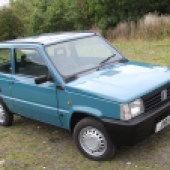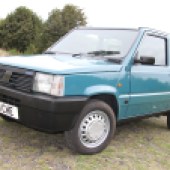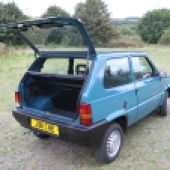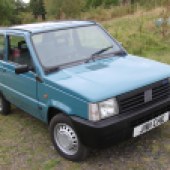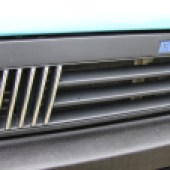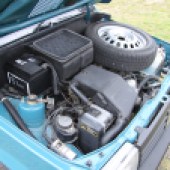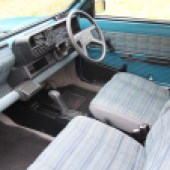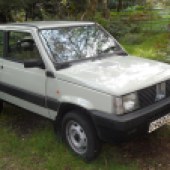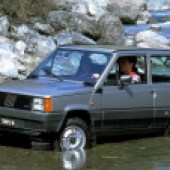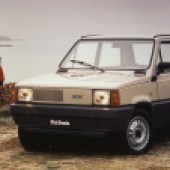Functional design and a fun driving experience ensured a strong following for the Fiat Panda and it’s just as popular today. Here’s how to get a good one
Words: Chris Randall
The notion of straightforward, utilitarian cars was hardly unfamiliar in the motoring world, with Fiat’s own 500 being a celebrated example. Yet in the late 1970s the firm revisited the concept, and the outcome was the much-loved Panda. Named not after the bear but after Empanda, the Roman goddess of travellers, it was styled by Giorgetto Giugiaro and was, in terms of simplicity, a genuine tour de force.
Its flat body panels and equally flat, side-to-side interchangeable glass created a distinctly boxy profile that delivered a light, roomy cabin. Inside, buyers were met with a wonderfully pared-back interior featuring washable fabrics and a rear seat that could be arranged in seven different ways, ultimately forming a hammock or a bed. It was nothing short of ingenious. Unveiled at the 1980 Geneva Motor Show, it heralded a model that would remain on sale in the UK until 1995 and continue in production in Italy until 2003.
The first version to reach Britain, the Fiat Panda 45, cost £2860 and used a 45bhp, 903cc engine taken from the Fiat 127. The Super model followed in 1982 with a five-speed gearbox, while the clever 4×4 arrived the next year and reached the UK in 1984 priced at £4390. The first car of its kind to feature a transverse engine, it used a Steyr-Puch-developed four-wheel drive system and a larger 965cc engine producing 48bhp. Surprisingly capable off road, it still offers plenty of mud-plugging entertainment today.
A major update came in 1986 when the Panda – now referred to as the Mk2 with model code 141A – gained the new 999cc FIRE engine and revised rear suspension, replacing the leaf-sprung live axle with a coil-sprung independent set-up (the 4×4 kept the earlier layout). Smoother exterior panels and one-piece door glass were added at the same time.
Another refresh in 1991 introduced new trim levels and the Selecta variant with a CVT gearbox, while the arrival of catalytic converters soon after saw a reduction in engine choices. The 4×4 was dropped from the UK line-up, and manual Pandas were fitted solely with the 999cc FIRE engine, while the CVT version later moved to an 1108cc unit. That’s more or less how things stayed until UK sales ended in 1995, by which point 161,501 Pandas had been sold. Several special editions appeared along the way to keep interest alive, including the Panda Habitat and the football-themed Panda Italia 90, while the 4×4 Sisley looked particularly smart.
Fiat Panda values
One thing worth noting is the sizeable gap between prices for two- and four-wheel-drive Fiat Panda models, with the latter’s go-anywhere capability and chunkier styling making it especially sought after. While a project-grade Panda can be found for as little as £1000, a rough-around-the-edges 4×4 will typically set you back nearer £2000-£2500.
If you’re after a more usable example that you can gradually improve, allow £1500-£2000 for a standard Panda and £5000 upwards for an all-wheel-drive version, with cars regarded as being in very good condition changing hands for £3000-£4000 – or £8000-£12,000 in 4×4 form. The finest two-wheel-drive cars (especially early ones) can fetch around £6500 or more, but unless you absolutely insist on concours quality, there are far more affordable ways to enjoy everything this charming Italian classic has to offer.
Insurance Costs
1991 Fiat Panda 1000CLX, £3000 value.
Example quote: £109.97 or £127.97 with Agreed Value.
Quotation supplied by Lancaster Insurance. Tel: 01480 400761
Quote based on a 45-year-old marketing manager, access to another car, no claims or convictions, club member, 3000 miles per year, no modifications, living in SP2 0HL. Disclaimer: Subject to underwriting criteria. An additional charge may be payable. Authorised and regulated by the Financial Conduct Authority.
Bodywork
Affordable and basic it may have been, but the Fiat Panda’s bodywork proved sturdier than many anticipated, and the introduction of partial galvanisation from 1990 only improved matters. Corrosion does affect them, of course, yet it’s often less severe than the Italian rust reputation might suggest. With that in mind, begin by examining the exterior panels, focusing on the lower edges of the doors and tailgate, the front lip of the bonnet, and the outermost sections of the wings and wheelarches. Replacement panels are easy enough to source, with Surrey-based specialist Ricambio offering a wide range of parts; doors are around £140 and rear wings roughly £215.
It’s also worth inspecting the sills closely, especially where they’re spot-welded to the floorpan. Rot can spread into the floor itself, resulting in more involved repairs, and sorting it properly may require removal of the outer sill to reach the affected areas. While checking the floors, look carefully inside the boot and pay close attention to the seams where it joins the inner rear wings; view it from within the wheelarch as well, and be aware that repairs here can be awkward. You should likewise check thoroughly for bubbling around the front and rear screens, as well as any evidence of water ingress into the cabin caused by corrosion around the scuttle.
If the car appears largely free of rust, it’s sensible to make sure exterior trim is present and undamaged, although availability is generally good and there’s a healthy supply of used items. Replacement bumpers are easy to obtain, and if sourcing proves tricky, expanding your search to mainland Europe usually solves the problem. Beyond the issues already mentioned, it’s simply a case of judging the overall condition and budgeting for any necessary remedial work.
Lastly, remember that the Fiat Panda Mk2 differs from the original far more than its looks might imply, so don’t assume parts will swap between the two.
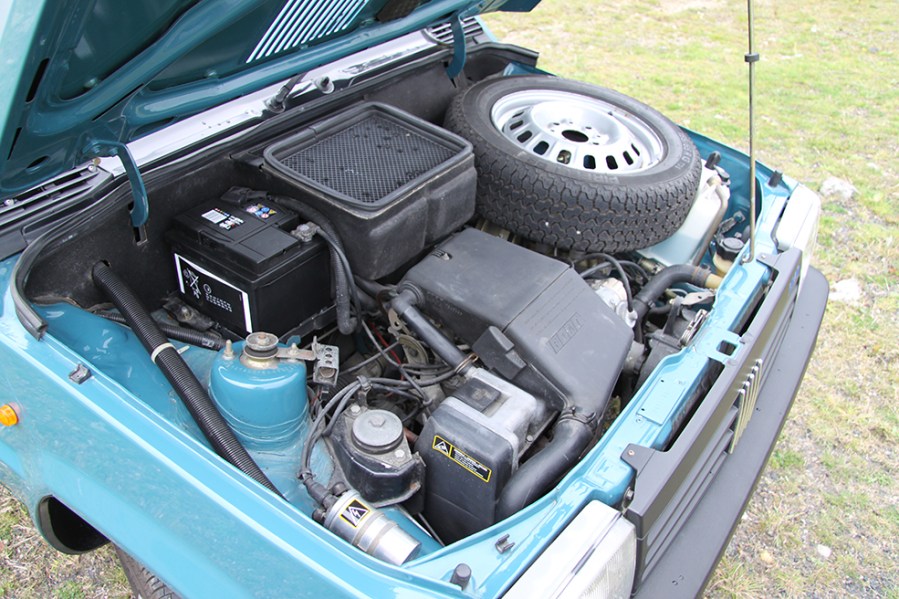
Engine and transmission
The engines fitted to the Fiat Panda are generally long-lived unless poorly maintained, and FIRE units can comfortably exceed 200,000 miles with proper care. Look for the usual signs of wear – excessive exhaust smoke, for instance – along with oil leaks and any indication that the cooling system is due an overhaul. Provided there’s evidence of regular oil and filter changes, there shouldn’t be too much cause for concern.
The 903cc engine may develop noisy valve gear and a tired timing chain, but the latter is inexpensive at under £50 and not difficult to replace. The FIRE unit uses a timing belt – a kit costs around £35 – and although it’s a non-interference engine, meaning belt failure isn’t catastrophic, proof of periodic replacement suggests diligent ownership.
For all engines, it’s sensible to check beneath the oil filler cap for any ‘mayonnaise’, though it’s usually the result of frequent short trips rather than a failed head gasket. Should a full rebuild be required, most components are still available, but in reality it’s easier and cheaper to source a decent second-hand engine; you can generally pick one up for £200.
Finally, use the road test to watch for any signs of rough running. The ignition system is very simple, so refurbishment is cheap and easy, but issues may also stem from a worn carburettor or problems with the fuel injection used on later models. The carburettor is a Weber unit with rebuild kits readily available, while the injection system could be Bosch or Weber; it’s typically reliable but diagnosing faults may require specialist expertise.
As for the transmission, the manual gearboxes are robust, with the most common problem being crunching when selecting second or third. This could point to failing synchromesh or worn bearings, so budget for a rebuild or a replacement ’box. Also watch for an especially loose gearshift; a repair kit for the early rod-operated setup costs around £15, while later cable-operated systems are generally better but harder to source parts for.
A CVT transmission was also offered, though reliability can be something of a lottery. If it proves troublesome, repairs can be difficult and finding a specialist willing to work on it isn’t easy, so the manual remains the safer choice.
This brings us to the popular and capable 4×4. The system is pleasingly simple, with drive to the rear wheels engaged via a dog clutch operated by a T-bar handle in the cabin. It’s not known for causing problems, and aside from checking for wear in the propshaft joints and listening for worrying noises, the main task is to ensure it functions correctly. You’ll need a loose surface to test it, and an indicator light on the dashboard should illuminate when it engages.
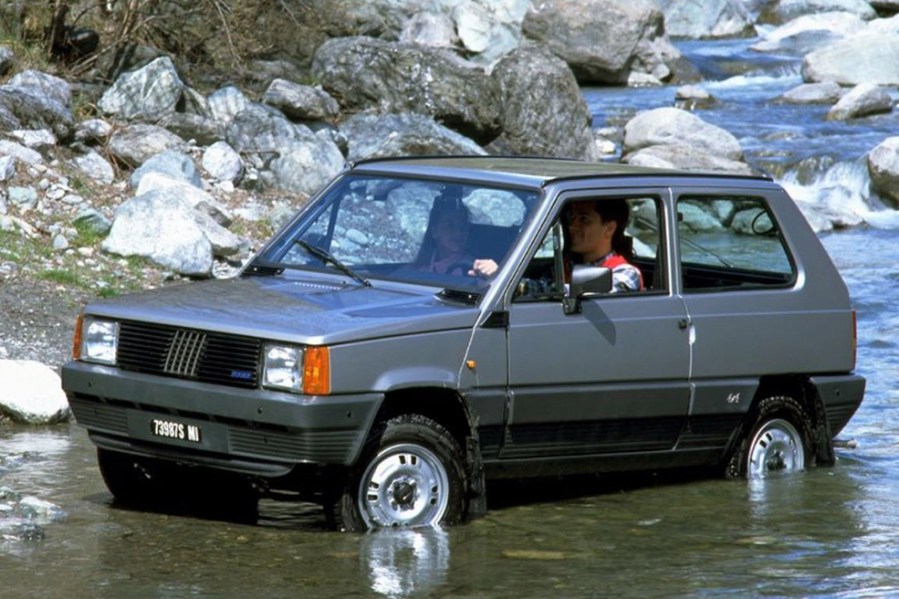
Suspension, steering and brakes
This was another area where the Fiat Panda proved admirably straightforward in its engineering, which is good news for anyone considering the characterful supermini today. The brakes comprised discs up front and drums and the back, and it’s a set-up more than capable of stopping such a featherweight car. You’ll just need to check for the usual wear and tear, and for signs of corrosion or seized parts than can result from lack of use – replacement bits are cheap and there’s nothing to faze a competent DIY-er when it comes to an overhaul.
It’s much the same story with the suspension, which launched with MacPherson struts up front and a beam axle aft with leaf springs. The test drive will quickly reveal any creaks or knocks that signal an impending overhaul, so just concentrate on looking for the usual culprits such as worn or perished bushes, tired front struts, or badly corroded or broken rear springs. It’s wise to scrutinise the integrity of the mounting points for the latter, too.
The arrival of the Mk2 signalled a swap to the ‘Omega’ rear axle with coil springs (although not for the 4×4) and its worth checking for corrosion both where the springs locate and for rust or fractures in the springs themselves; new ones cost less than £100 per pair, so replacement won’t exactly strain the wallet.
The steering should feel light and accurate with no obvious play that points to wear in the rack or track rods. And finally, while the Panda makes for an entertaining and frugal daily-driver classic, it’s worth checking that cars saved for high days and holidays aren’t sitting on aging tyres.
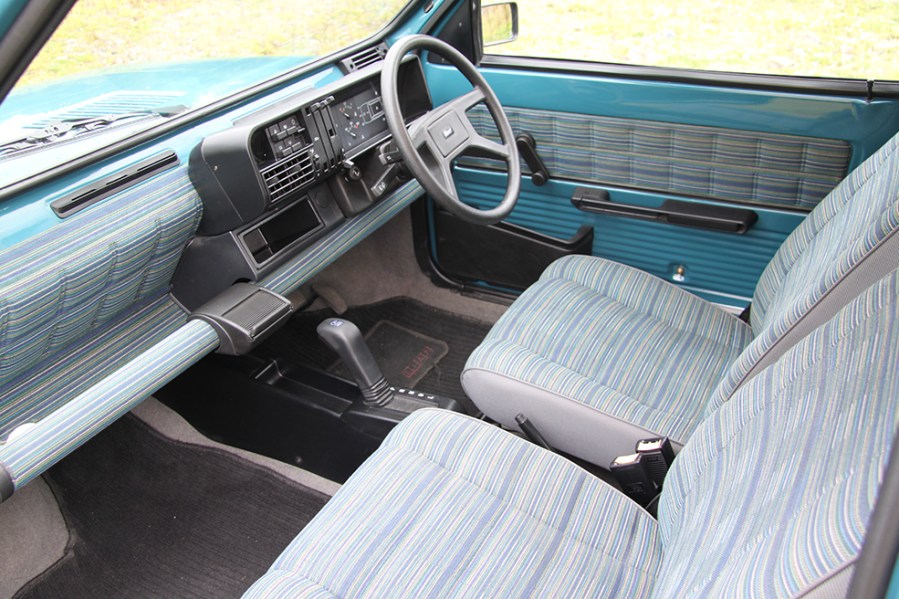
Interior, trim and electrics
Small cars of this period were never renowned for lavish interiors, but even by those expectations the Fiat Panda’s cabin was admirably straightforward – yet still clever and practical. The advantage for anyone looking at these cars today is that not only is it very usable, but any wear or damage is immediately obvious. Negotiate accordingly if you’ll need to replace stained or torn seat upholstery, though the good news is that sourcing second-hand parts is generally easy.
Carpets are inexpensive to renew (check underneath for signs of damp or corrosion in the floorpan), but it’s worth inspecting the condition of the plastic trim more closely. The boxy instrument binnacle can be rather fragile and, with replacements increasingly scarce, you may have little choice but to attempt repairs yourself if you discover cracks or other damage.
The Panda’s simplicity also carries over to its electrics – and with virtually nothing in the way of modern gadgets, it shouldn’t take long to confirm that everything functions as it should. A quick check of the gauges and switchgear will usually suffice, and most issues stem from poor connections or corroded earths; a run through with a multimeter should pinpoint the fault. Burnt-out headlight switches or a worn windscreen wiper linkage are other things to look out for, and make sure the door locks and window winders operate correctly.
Fiat Panda: our verdict
The passage of a few decades has done nothing to lessen the little Fiat’s charm. If anything, its blend of stylish design, straightforward engineering and hassle-free ownership has drawn a fresh wave of buyers, keeping values consistently strong.
With prices likely to increase further, the time to grab a Fiat Panda is now.
MODEL TIMELINE
1980
Fiat Panda launched at the Geneva Motor Show – focus on simplicity and affordability, meaning a simple design, flat glass and hammock-style seats. 652cc and 903cc engines from the 126 and 127 respectively.
1982
Panda 45 and 45 Super introduced with more power and better trim.
1983
Panda 4×4 released, developed with Steyr-Daimler-Puch. Quickly gains a strong following for its off-road ability.
1986
First facelift brings introduction of FIRE engines, improved suspension and electrics.
1990
Panda Italia 90 launched to celebrate Italian World Cup – sports unique ‘football’ wheel trims. Panda Elettra electric version launched, powered by lead-acid batteries and offering 62-mile range.
1991
Mild facelift brings new grille and interior trim, as well as Selecta CVT and five-speed manual gearbox options.
2003
Original Panda production ends after more than 4.5 million built. ‘169’ successor proves similar smash-hit.


